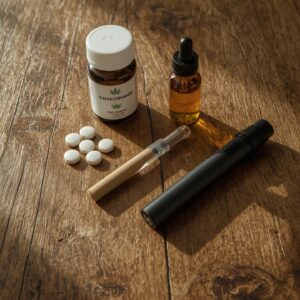Good sleep has become a luxury in today’s world of busy roads, long working hours, traffic, junk food, stress, and anxiety. Our world gets more complex every day, and keeping up with it is no easy feat. Whether it’s difficulty falling asleep, staying asleep, or achieving deep restorative rest, sleep problems take a heavy toll on both body and mind. With pharmaceutically prescribed medicines, we can relieve ourselves of this weight, yet not without side effects. This is where cannabis research comes in.
Common Sleep Issues

Insomnia (difficulty falling or staying asleep)
Insomnia is one of the most common sleep disorders, leaving people awake for hours despite exhaustion. It often stems from stress, poor sleep hygiene, or underlying health conditions.
Sleep latency (taking too long to fall asleep)
Sleep latency refers to the time it takes to drift off after lying down. Long delays often indicate overstimulation, anxiety, or an irregular sleep routine.
Restless sleep or frequent waking
Even if you fall asleep easily, frequent waking can leave you unrefreshed. Causes include stress, environmental disruptions, or underlying health issues.
Nightmares or disrupted REM cycles
REM sleep is where dreaming and memory consolidation occur. Disruptions, such as nightmares or waking during REM, can cause grogginess and emotional imbalance.
Irregular sleep schedules or jet lag
Circadian rhythms thrive on consistency. Irregular schedules, shift work, or travel across time zones confuse the body’s internal clock.
Take a mental note of that last one. While there are many others I could list, I wanted to focus on the most common and curable disorders. Irregular sleep schedules affect 85% of people out there, and research has shown that irregular sleeping schedules take an enormous toll on long-term health.
How Cannabis May Help with These Sleep Problems

Our bodies have a system called the “endocannabinoid system” which has receptors that bind to THC and CBD to alter our chemistry, affecting other systems like sleep, mood, stress, and anxiety, which of course play a huge role in this conversation. So, let’s get into the juice of it.
THC – Shortens sleep latency
THC, when bonded with our great and powerful CB1 receptors (found throughout our nervous system), brings about calm to neural activity. This reduces sleep latency, and falling asleep becomes as easy as counting sheep. Dosages do matter in this case; you don’t want to feel groggy the next day.
CBD – Reduces anxiety and stress
CBD has an anxiolytic effect, lowering the overactive stress response. By reducing cortisol and calming racing thoughts, it prepares the body for rest, naturally reducing stress and anxiety without creating an intoxicating effect. As well as no other side effects have been founded in heavy research yet either.
Myrcene (terpene) – Sedative qualities
One of the most common terpenes found in cannabis. Linked to feeling like “couch lock” and “drowsiness,” this chemical is also found in other plants like lemongrass and hops. Coming across as earthy, herbal, and spicy on the palate and nose.
Linalool (terpene) – Relaxation and calm
Linalool is a floral terpene also found in lavender, prized for its soothing aroma. It may promote serotonin release, lowering anxiety and easing tension. Often recommended for sleep and stress in strains such as Zkittlez and Amnesia Haze, complementing the effects of CBD and THC.
Pain relief – THC + CBD synergy
Nighttime pain is one of the biggest barriers to rejuvenating sleep. THC and CBD together reduce inflammation and dull pain signals in the body. This dual action makes it easier to fall asleep without tossing and turning. For semi-chronic conditions, the combination may provide a safer alternative to opioids.
REM cycle modulation – Nightmare reduction
Cannabis can be known to affect your dreams in such a way that they seem to slowly disappear over long-term use. Majority thanks to THC, yet reducing REM can’t always be good for you. With short-term use for PTSD patients or someone suffering from trauma, it can be helpful. REM’s importance in our lives is vital, though.
All of this is great; remember that every person is vastly different in their history, chemistry, and mindset. Some people may have bad reactions to this drug, worsening their symptoms and increasing anxiety. So, we have to be careful and consult our doctors before taking chances.
Importance of Cannabis Dosages & Methods

Starting from the least healthy, going to the healthiest
Smoking (Least Healthy)
Combusting cannabis flower produces cannabinoids alongside tar, carbon monoxide, and polycyclic aromatic hydrocarbons. These byproducts irritate lung tissue and increase oxidative stress, impacting respiratory health. Absorption is rapid via alveoli, with effects felt within minutes, making it efficient but harsh.
Dosage: Let’s take your average 1-gram pre-roll (joint) of around 17–21% THC.
Never used before: 1 drag/pull/inhale is enough. Wait for the effects to come and go before trying again the next day (where you can take 2 drags/pulls/inhales), depending on your previous day’s experience.
Infrequent user: 2–3 small pulls/drags/inhalations to be safe. Depending on your previous experiences and comfort level. Others stick to the dosage recommendation above.
Frequent user: If you have smoked within the last 2–4 days, feel free to enjoy up to 6 inhales/pulls/drags or 3 rounds in case you’re sharing with others. If it has been longer than 4 days, I would recommend sticking to the dosage above for infrequent users.
Experienced: Meaning you smoke every day, you don’t need me recommending a dosage for you. You know your tolerance well enough by now.
Vaping (Moderately Unhealthy)
Vaporizing heats cannabis or distillate to release cannabinoids without full combustion. This lowers exposure to tar and carcinogenic byproducts, although heavy metals may still be present depending on the device. Onset is nearly as fast and usually a lot stronger than smoking, since the levels of THC can be up to 5× stronger. It is considered less damaging than smoking, though long-term inhalation safety remains under study.
Dosages: For this method of consumption, I would recommend following the same dosages as above for smoking, except use more caution as vapes are a lot stronger. Feeling uneasy? Consume half of what you’re thinking. Less is more, especially if you are using it only for sleep.
Edibles (Healthy)
The prize in disguise. Consuming THC through food products means delayed onset, 30 minutes to 2 hours. Lasting a lot longer and feeling a lot stronger as well, so being careful with dosage is key. Cannabinoids consumed orally undergo first-pass metabolism in the liver, where THC converts into 11-hydroxy-THC.
No Experience: No more than 10 mg for a first-time user in one day or night. Ask who you are purchasing it from for a recommendation of 10 mg gummies, chocolate, etc. Do not let others convince you that you can take more.
Infrequent user: I would recommend the same 10 mg or less unless your previous experiences have all been wonderful and you’re confident. Then take 20 mg at your own risk.
Frequent user: Unless you have smoked or consumed edibles recently (within the last 3 days), I would recommend taking no more than 30 mg. This effect level is still highly controllable and often puts people right to sleep.
Experienced: When it comes to edibles, being experienced doesn’t even mean much. Since the liver processes it, the effects will always be… effective. I wouldn’t recommend over 100 mg, especially if you haven’t consumed in over 3 days.
Tinctures and Oils (Healthiest)
Faster acting, purest way to consume the product without direct harm to the body. Cannabinoids are absorbed through oral mucosa. Effects are felt within 10–15 minutes, and precise dosing makes this much safer. Often the most expensive method, depending on consumption amount. They can also be added to food.
Beginner: Tinctures and oils onset effect takes 10–15 minutes (usually), and the experience is often clearer cut. Dosage recommendations online might say 1–2 mg or 5 mg. I would say 5–10 mg. A drop is often 10 mg at the least. So half a drop if you feel cautious or a full one if you’re confident. Note: Remember to read instructions on the bottle first.
Intermediate: When in a place of comfort, a 10 mg dosage for better sleep is recommended. This can reduce sleep latency, improve deep sleep, and won’t give you a groggy feeling the next day.
Frequent user: For someone who takes regularly and is finding the dosage too small, I would recommend no more than 30 mg before bed at night or you need to take a tolerance break. This means at least 1 month without usage of the product to reset your body.
Reliability and Withdrawals

This drug is no different from the others when we talk about withdrawals. There may be a significant difference in side effects, being that there are close to none (at the correct dosage). Although, once you have used the product daily for a long period of time (over 6 months), you might need to take a tolerance break.
The importance of the tolerance break is to detoxify your body, lower your tolerance, and balance out your endocannabinoid system. This process should last a month, and one will experience withdrawals such as lack of sleep, bad dreams, nausea, lack of appetite, and others, dependent on your previous dosages and whether you were using THC, CBD, or both.
Final thought
Sleep is the foundation of health, and cannabis offers a unique, natural alternative to the common quick fixes we’ve come to rely on. While it can calm racing thoughts, ease pain, and help the body transition into rest, it is not a one-size-fits-all solution. Everyone’s body chemistry, tolerance, and needs are different, which means the right strain, dosage, and method of consumption will vary from person to person.
Always consult your doctor or physician about these matters before attempting them on your own.

